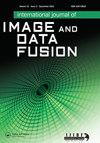ASTER卫星图像、地球化学和地质数据的融合,用于伊朗中西部阿斯塔纳花岗岩侵入体的金矿勘探
IF 1.8
Q3 REMOTE SENSING
International Journal of Image and Data Fusion
Pub Date : 2021-04-19
DOI:10.1080/19479832.2021.1915395
引用次数: 6
摘要
摘要利用ASTER图像、地球化学、岩性和构造数据,对阿斯塔纳花岗质岩体及其周缘进行了矿产潜力填图(MPM)。将独立分量分析(ICA)和匹配滤波(MF)技术应用于ASTER数据的蚀变矿物组合检测。利用ICA技术绘制了与黄铁矾和绿泥石/绿帘石有关的绢泥蚀变矿物。从n维可视化(n-DV)工具获得的MF分数图像有助于检测与金矿相关的针铁矿、赤铁矿、褐铁矿、白云母、高岭石、伊利石、绿泥石和绿帘石。Cu、Pb、Zn、Au的分布被认为是地球化学异常层的成因。强Cu、Zn、Au异常与金矿化有关。同时考虑了含金矿化的岩性单元以及NE-SW和NW-SE走向的交汇。利用模糊逻辑模型(FLM)对研究区蚀变层、地球化学层、地质层和构造层进行融合,生成了找矿图。在研究区中部和东南部确定了几个高远景区。大部分已圈定的勘探目标都与深部岩体或其周围的变质岩有关。为研究区今后找矿提供了一条可行的途径。本文章由计算机程序翻译,如有差异,请以英文原文为准。
Fusion of ASTER satellite imagery, geochemical and geology data for gold prospecting in the Astaneh granite intrusive, West Central Iran
ABSTRACT In this study, ASTER imagery, geochemical, lithological, and structural data are exploited for Mineral Potential Mapping (MPM) of the Astaneh granitic pluton and its surrounding area. The independent component analysis (ICA) and Matched Filtering (MF) techniques are applied to ASTER data for detecting alteration mineral assemblages. Sericitically argillically altered minerals associated with jarosite and chlorite/epidote are mapped using the ICA technique. MF fraction images derived from n-dimensional visualisation (n-DV) tool facilitated detecting goethite, haematite, limonite, muscovite, kaolinite, illite, chlorite and epidote associated with gold occurrences. The distribution of Cu, Pb, Zn and Au is considered for generating geochemical anomaly layers. Strong Cu, Zn and Au anomalies are found to be associated with gold mineralisation. The lithological units hosting gold mineralisation and intersection of NE–SW and NW–SE trending lineaments are also considered. Fuzzy Logic Model (FLM) was used to generate gold prospectivity map for the study area by fusing the alteration, geochemical, geology and structural layers. Several high prospective zones are identified in the central and southeastern part of the study area. A majority of delineated exploration targets are either linked to the plutonic body or its surrounding metamorphic rocks. This study demonstrated a viable approach for future gold prospecting in the study area.
求助全文
通过发布文献求助,成功后即可免费获取论文全文。
去求助
来源期刊

International Journal of Image and Data Fusion
REMOTE SENSING-
CiteScore
5.00
自引率
0.00%
发文量
10
期刊介绍:
International Journal of Image and Data Fusion provides a single source of information for all aspects of image and data fusion methodologies, developments, techniques and applications. Image and data fusion techniques are important for combining the many sources of satellite, airborne and ground based imaging systems, and integrating these with other related data sets for enhanced information extraction and decision making. Image and data fusion aims at the integration of multi-sensor, multi-temporal, multi-resolution and multi-platform image data, together with geospatial data, GIS, in-situ, and other statistical data sets for improved information extraction, as well as to increase the reliability of the information. This leads to more accurate information that provides for robust operational performance, i.e. increased confidence, reduced ambiguity and improved classification enabling evidence based management. The journal welcomes original research papers, review papers, shorter letters, technical articles, book reviews and conference reports in all areas of image and data fusion including, but not limited to, the following aspects and topics: • Automatic registration/geometric aspects of fusing images with different spatial, spectral, temporal resolutions; phase information; or acquired in different modes • Pixel, feature and decision level fusion algorithms and methodologies • Data Assimilation: fusing data with models • Multi-source classification and information extraction • Integration of satellite, airborne and terrestrial sensor systems • Fusing temporal data sets for change detection studies (e.g. for Land Cover/Land Use Change studies) • Image and data mining from multi-platform, multi-source, multi-scale, multi-temporal data sets (e.g. geometric information, topological information, statistical information, etc.).
 求助内容:
求助内容: 应助结果提醒方式:
应助结果提醒方式:


